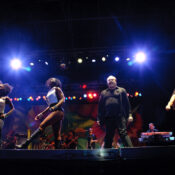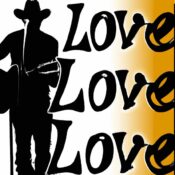With all of the diversity and complexity that can be found within music, it’s rare to become the group that is most symbolic of a particular sound. When it comes to Southern Rock, the avatar of the style is unquestionably Lynyrd Skynyrd. After releasing a classic debut album in 1973, Skynyrd enjoyed triumph and endured unimaginable tragedy on the road to rock immortality. Here’s how they got started.
The story of the band began in sweet home . . . Jacksonville, Florida? That’s where the earliest version of the group formed in 1964. Acquainted with one another through local bands and baseball teams, Ronnie Van Zant (vocals), Gary Rossington (guitar), Bob Burns (drums), Larry Junstrom (bass), and Allen Collins (guitar) formed their own group. After using a series of different names for the next few years, the group landed on Leonard Skinnerd in 1969. Though Leonard Skinner was a character in the novelty tune “Hello Muddah, Hello Fadduh,” the real Leonard Skinner was a high school gym teacher who hated long hair. Rossington had even dropped out of high school over the issue. By the following year, the group had reshaped the name into the familiar bane of music journalists and spellcheckers everywhere, Lynyrd Skynyrd.
Lynyrd Skynyrd honed their sound in in the southern U.S. by constantly performing. The Southern Rock style of the band sprang from an amalgam of country and blues influences mixed with the aesthetic of a rock band, notably the emphasis on guitar in general and guitar solos in particular. Prior to the recording of their first album, the band went through some line-up changes. The departing Jundstrom’s bass slot was filled by Greg T. Walker, then Leon Wilkeson. Rickey Medlocke was added as second vocalist and second drummer to fill out the live sound. And longtime roadie Billy Powell became a member when the band realized his talents at piano and keyboards. It was that configuration of the band that came to the attention of Al Kooper of Blood, Sweat & Tears in 1972.
“Gimme Three Steps” (Uploaded to YouTube by Lynyrd Skynyrd)
Kooper was an extremely talented writer and musician who, in addition to his own projects, was known for laying organ and keys down on instant classics like The Rolling Stones’s “You Can’t Always Get What You Want” and Bob Dylan’s “Like A Rolling Stone.” By the time he met Skynyrd, he had his own label under MCA Records called Sounds of the South. He signed the band and would produce their first album (as well as their following two).
The band experienced brief turmoil when Wilkeson suddenly left the band over the inner conflict he was experiencing over prospective fame. Ed King filled his slot form much of the recording of the album. However, Wilkeson returned during the process and the band welcomed him back. They also decided to keep King, who moved over to a third guitar. The band was already deploying a three-guitar sound in the studio with the benefit of recording extra tracks, but King’s presence on stage would give them a live version of what would later be dubbed the “three-guitar assault.”
Skynyrd showed wry self-awareness with the title and spelling of their debut album, (Pronounced ‘Lĕh-‘nérd ‘Skin-‘nérd). Being fully aware that their stylized nomenclature could be confusing, they leaned into the gag. That humor extended to the third track on the album, “Gimme Three Steps,” which recounted a real situation in which Van Zant danced with the wrong man’s woman. The group would issue the song as their lead single. It was a solid introduction to the band, giving the perfect snapshot of their sound and attitude. Though it didn’t chart, it became an immutable staple of rock radio.
“Tuesday’s Gone” (Uploaded to YouTube by Lynyrd Skynyrd)
Another standout on the first record was “Tuesday’s Gone.” Though never released as a single, it also became popular on rock radio. Beyond that, it’s been used in a number of films, most notably under the opening narration of Adam Sandler’s Happy Gilmore and in Cameron Crowe’s ode to ’70s rock, Almost Famous. The song has also been subject to many covers by prominent acts like Metallica (whose version featured a guest appearance by Rossington on guitar).
“Free Bird” (Uploaded to YouTube by Lynyrd Skynyrd)
But the elephant, or should we say Big Bird, in the room was the album-closing “Free Bird.” Nine minutes on the record and fourteen when played live, “Free Bird” was the kind of epic statement song that bands of the decade were almost required to have. The opening lyric had actually come from Collins’s girlfriend (and future wife) Kathy, who hit him with the question, “If I leave here tomorrow, will you still remember me?” Though the song is credited to Collins and Van Zant, Rossington’s guitar compositions factored into the late song guitar solos, and Powell contributed to the introduction. Over time, “Free Bird” became an incredibly popular tune and their show closer. While it wasn’t released as a single during the cycle of the first record, the band put it out after “Sweet Home Alabama” from their second album, Second Helping, went to #8. “Free Bird” went to #19 in the States and would be certified Platinum. Like many of the band’s songs, it never left classic rock radio, and the shouts of its name continue to haunt bands both national and local at concerts around the world.
“Sweet Home Alabama”
Legendary rock writer Robert Christgau was an early proponent of the band, giving exemplary reviews to their first several albums. Of the debut, he noted that the band tended to undermine their own “good-old-boy” image by tweaking expectations, in the that the dramatic climax of “Gimme Three Steps” has the protagonist run for his life rather than fight. “Free Bird” became the song that stood above everything else that the band did; it was included in The Rock and Roll Hall of Fame’s 500 Songs That Shaped Rock and Roll. Additionally, the original 1973 recording of the song was inducted into the Grammy Hall of Fame in 2008. As a live band, they were regarded as a potent draw, cutting their teeth with bigger venues by opening for acts like The Who before becoming successful headliners.
“Call Me the Breeze” (Uploaded to YouTube by Lynyrd Skynyrd)
(Pronounced ‘Lĕh-‘nérd ‘Skin-‘nérd) firmly established the band as a new force in music, and they kicked out five successful albums by 1977. During this time, Burns and King departed and were replaced by Artimus Pyle and Steve Gaines. Gaines’s sister Cassie joined the touring group as a back-up singer. Unfortunately, the unthinkable happened three days after the release of 1977’s Street Survivors. The band performed in South Carolina on October 20, 1977; during their subsequent flight to Louisiana, the plane ran out of fuel and went down in Mississippi. Van Zant, the Gaines siblings, the group’s assistant road manager Dean Kirkpatrick and pilots Walter McCreary and John Gray were killed instantly. Most of the surviving band members were injured. Collins broke two vertebrae in his neck and narrowly avoided the amputation of his right arm. The band initially broke up, though surviving members would perform once in 1979 at Charlie Daniels’ Volunteer Jam V. Over the next few years, many of the band members would play together in various combinations, including the Rossington Collins Band. A car accident in 1986 left Collins paralyzed from the chest down, ending his stage career.
“Smokestack Lightning” (Uploaded to YouTube by Lynyrd Skynyrd)
Ten years after the accident, Lynyrd Skynyrd reunited. Rossington, Powell, Wilkeson, Pyle, and King returned, and Collins joined as the group’s musical director. The gaping hole at lead vocals left by the absence of Ronnie Van Zant was filled by a selection that was simultaneously surprising and obvious: youngest brother Johnny Van Zant. While Ronnie had been the first rock star in the family, middle brother Donnie Van Zant had found his own fame as the creator of 38 Special. Johnny, for his part, had been playing with his eponymous band and releasing solo albums for years. Both honored and humbled by the invitation, Johnny took on the role of lead singer and has remained at the post ever since.
In the intervening years, the band has released nine albums. 2012’s Last of a Dyin’ Breed reached #14 on the Billboard charts, making it the group’s most successful release since Street Survivors. In 2006, the group was inducted into the Rock and Roll Hall of Fame; the Hall recognized Collins, Pyle, Powell, Burns, King, Rossington, Wilkeson, Steve Gaines, and Ronnie Van Zant as inducted members. The band had, at various times, indicated that they would retire from touring. In March of 2023, Gary Rossington, the last original member of the band, passed away. The following month, the band announced their intention to continue, as well as completing an album that had been in the works before Rossington’s death.
For five decades, Lynyrd Skynyrd has been the standard-bearer for Southern Rock. Though the original members are gone, the legacy of musicianship is deeply ingrained in the present version of the group. And in Johnny Van Zant, there exists a tangible connection, a brother bound not only by blood, but a shared love of song. There’s little doubt that the band answered its own musical question: regardless of whose stayed or traveled on, their fans will still remember them.
Become a Saturday Evening Post member and enjoy unlimited access. Subscribe now




Comments
“When it comes to Southern Rock, the avatar of the style is unquestionably Lynyrd Skynyrd.”
Unquestionably? I don’t know about that; more like it depends on whom one asks. For me, that “avatar of the style” has always been/will always be the Allman Brothers Band…….
I saw them twice in the 70s the best was at Super Bowl of rock lll in soldier Field in Chicago. What a star-studded lineup. 38 special, Journey, REO, Skynyrd, Nugent. Ronnie had a busted ankle and had a cast up to his knee. He still rocked the place. It’s known as the milk jug concert.
My friend Guy House ( that’s his name ). Guy grew up in Jacksonville, FL. He went to the Jug to watch them.
Best high school band ever.
His school was 3 miles from theirs.
Lenard Skynyrd was the name of thier basketball coach. Who told them to try something different.
And here WE are.
LS: a very good band, but not in ‘the best rock & roll bands ever’ bracket. The bands in that are Led Zeppelin, Jimi Hendrix Experience, Pink Floyd, Rolling Stones and possibly The Doors, Black Sabbath and Deep Purple.
Their plane crashed two days before my 21st birthday, I woke to the news of the tragedy and walked across the street to the beach walked out on San Clemente pier and cried like a baby, then I noticed that their music was in the waves lapping against the pier. RIP to all those who have gone before me!
The best band in the history of Rock and Roll, period!
In the Rural South we LOVE our Skynyrd, and even to a higher degree in “Sweet Home Alabama,” (Roll Tide Roll) where the skies are so blue. You are not going to attend a home football game at the University of Alabama’s Bryant-Denny Stadium without hearing it played through the speakers and getting the crowd into the game. It’s one of most rocking collegiate football stadiums in the US, plus you see a good football team…I’m part of the Class of 1993. Anyway, getting back on Skynyrd, I have only one tattoo on my body and it’s about my personal anthem….Anyone who knows who I am agree too that I am truly a “Free Bird.” I always have been and always will be.
JaJa……nitbick wouldve been ronnies next song
Nothing like LYNNRD SKYNNARD In this life time gre arou d it….66 now
That is correct. His “try out” for the band was a live show. Steve, Allen, Gary, and Ed are all playing together now, R.I.P. brothers.
This band is still great!
Not to nitpick, but Cassie Gaines was already singing with Lynyrd Skynyrd when she suggested adding Steve after Ed King had left.